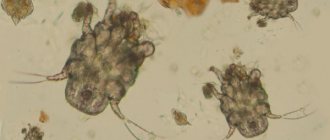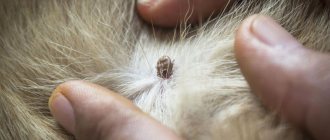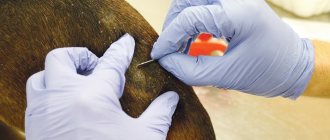What is otodectosis in cats?
A disease of the outer ear caused by the microscopic parasite Otodectes cynotis is known under such names as otodectosis in cats, parasitic otitis media, ear scabies, and ear mites.
At the beginning, one ear is most often affected, then the disease spreads to the second. Also, with otodectosis in a cat, the parasite is able to settle in other areas: neck, tail, pelvic area. This is explained by the fact that the animal curls up into a ball when it sleeps. Externally, it may look like dermatitis, allergies, flea bites.
Under good living conditions, proper nutrition, and regular ear cleaning, otodectosis in some cases goes unnoticed by the owner and is asymptomatic. However, if living conditions worsen, with unbalanced feeding, or weakened immunity, ear mites can enter the active stage. Then the disease acutely manifests characteristic symptoms and treatment directly depends on the condition of the “patient”.
In kittens and young animals the disease is severe. A kitten becomes infected especially quickly from other animals and from its mother.
Many cats are carriers of mites without any external manifestations.
Briefly about the pathogen
Otodectes cynotis, the causative agent of the disease, is so small that it is difficult to see with the naked eye. Its body dimensions are approximately 0.2-0.5 mm. However, if you examine with a magnifying glass what an ear mite looks like, you can see slowly moving pale yellow, white dots. The parasite feeds on skin scales from the ear canal of animals. Lives on the surface and does not dig.
The life of a tick lasts 3 weeks:
- Females lay eggs and attach them to the skin with a viscous substance and cement them. Each female lays 5 eggs per day.
- After 4 days the larvae appear. Within 3-10 days they begin to actively feed. Then comes the rest phase (from 10 to 30 hours).
- The cycle changes and the larvae move into different stages of development (protonymph and deutonymph).
- While in the deutonymph stage, the larvae attach themselves to the males. And if the deutonymph is a future female, then when she becomes an adult, she already turns out to be a carrier of eggs.
An adult lives on average 2 months. Life outside the animal lasts approximately 12 days.
Features of the disease
Otodecosis in cats is caused by the microscopic (about ½ mm) insect Otodectes cynotus.
The parasite has a whitish oval body and jointed limbs. It loves moisture and warmth, so it parasitizes inside the animal’s ear canal, feeding on skin scales, blood, and lymph. Outside the host's body, the tick can live for about two months. In most cases, the parasite affects both ears of the cat. The likelihood of infection is especially high during the warm and humid seasons - spring and early autumn. The risk group includes kittens under one year old and weakened animals. It may take several years from the moment of infection to obvious signs of the presence of a tick. The disease manifests itself especially clearly when a bacterial infection is added to the skin damage by the parasite. Due to itching and pain, an exhausted pet cannot sleep or eat.
How does infection occur?
Otodectosis is a highly contagious disease.
Even a completely indoor cat that does not roam outside can become infected with ear mites at any time of the year.
If there are several cats in the house and one is diagnosed with otodectosis, then we can assume that the others are also sick.
Infection occurs through contact with sick animals, through objects (combs, bedding, carriers), or the owner brings the parasite from the street on shoes or clothes.
How to prevent otodecosis
In most cases, tick damage to a cat's ears can be prevented. To do this, you should adhere to the following preventive measures:
- periodically inspect your pet’s ears for scratching, redness, swelling, and scabs;
- regularly clean the external auditory canal;
- do not allow communication with unfamiliar animals;
- strengthen the cat's immune system.
Paying close attention to your pet and promptly seeing a doctor will help avoid health problems.
Otodectosis in cats: symptoms
To feed, the parasite injures the animal’s skin, from which a liquid is released that serves as food for it. Such microtraumas, as well as secretions and excrement released during life, irritate the skin and cause severe, unbearable itching. To alleviate the condition, the animal constantly shakes its head, scratches its ears with its paw, and rubs them against objects.
Due to mechanical damage to the skin on the back of the head and ears, scratches and abrasions are found, and patches of bald patches may appear. If the eardrum is damaged, the pet tilts its head to the side.
If left untreated, the condition worsens, and inflammation gradually develops - otitis media. Therefore, otodectosis is also called parasitic otitis media.
Over time, the inner surface of the ears turns red, the skin in this area thickens and gathers into folds. If the process is not stopped, the inflammation spreads to the eardrum, the inner ear and further penetrates the brain. In this condition, the pet’s body temperature rises, lethargy, and convulsions or seizures appear.
The animal's behavior changes:
- sudden movements appear, running to nowhere;
- meowing when scratching ears;
- The cat presses his ears and does not allow his head to be stroked or his ears to be touched.
To understand what is happening to the cat, the owner needs to examine the ears. It will not be possible to examine the parasites. But the signs of ear mites in cats are immediately clear - an atypical color of plaque and severe itching.
If normally a cat's earwax is light with shades of yellow or brown, then with otodectosis the contents of the ear are dark brown and even black, resembling coffee grounds (as in the photo below). In this case, sulfur comes in different consistencies: dry, wet, loose, hard, pasty.
If there is an inflammatory process, an unpleasant odor comes from the ear.
Diagnosis of otodectosis
In a veterinary clinic, the diagnosis is made based on examination and examination of the contents of the ear under a microscope.
Basic methods:
- Using a special instrument, the doctor sees moving white dots.
- Studying sulfur under a microscope allows you to examine adults, larvae and eggs.
- The "positive ear" method. The doctor wipes the ear canal, and the cat reacts by trying to scratch with its hind paw.
If inflammation (otitis media) has developed, diagnosis becomes difficult. The fact is that with otitis media, an acidic environment is created in the ear, in which parasites die. Therefore, microscopy may not show results.
Also, before treating for otodectosis, the doctor must exclude other diseases that lead to inflammation of the outer ear: allergies, flea dermatitis and other types of parasites.
Prevention measures
To reduce the risk of your cat developing acariasis, you should follow these rules:
- Protect your pet from contact with stray and sick animals;
- Regularly, once every 2 months, treat the cat with universal insectoacaricidal preparations;
- With the help of a balanced diet, including vitamins, maintain high immunity of the animal;
- Follow the rules for caring for your cat, including cleaning its ears if necessary;
- Have your animal examined by a veterinarian regularly.
How to treat ear mites in cats
Before starting treatment for otodectosis in cats, many factors are taken into account:
- Conditions of keeping (does the cat go outside).
- The severity of the condition.
- Presence of other animals at home.
If there are other pets in the house, then general treatment is carried out. Treatment of the premises and objects is not required, since the parasite does not survive well in the environment. There is also no need to change your diet and lifestyle.
It is more effective to treat otodectosis in a cat that does not go outside and is kept entirely indoors using systemic medications. This is one way to get rid of ticks forever. If the cat is walking and in contact with other animals, parasites are removed with acaricidal preparations that are applied topically.
There is no quick cure for ear scabies in cats. On average, treatment takes 1-1.5 months.
It is important to keep your ears clean throughout your treatment. Otherwise, the cat’s ear mite takes refuge in wax and secretions, and acaricidal agents do not penetrate to the place of refuge.
Therapy and care
Many people are interested in how to treat ear mites in cats if there are other animals in the house? First, you need to isolate the sick person from other animals, throw out all bedding, rugs and other textiles on which the cat was located from the house. The apartment is thoroughly washed with disinfectants. The treatment of a sick animal is carried out wearing gloves and clothing that is not taken out of a closed room or closet.
The main rules for treating ear mites in cats include the following:
- If there are several furry inhabitants (cats or dogs) in the house, then everyone will have to be treated - regardless of whether they have the disease or not. For kittens and pregnant animals, it is worth using a gentle spray.
- Don’t forget about careful cleaning of your home. It is better to throw away bedding and rugs, or, as a last resort, boil them.
- It is worth remembering that a pet’s recovery directly depends on the strength of its immunity. Provide the patient with balanced, high-quality food and include vitamins in the diet.
- Clean your home more often. Remember that harmful microorganisms settle on various objects, in cracks in the floor, in fabrics and even in books.
- Never use products containing ethyl alcohol to treat ear mites in cats.
The duration of treatment for ear mites in cats will depend on the degree of neglect of the disease and on the drugs chosen. Simple cases can be resolved in one to three weeks. But in case of complications, when there is a secondary infection, the treatment process will drag on for several months.
Hygiene procedures and processing
All medications will be prescribed by a doctor. He will also tell you about the treatment regimen. Further actions will be approximately as follows:
- First of all, the surface of the ears is cleaned of crusts and dried particles, and the hair that gets in the way is trimmed.
- Warm hydrogen peroxide is carefully and slowly injected using a syringe. 2-3 ml is enough. You have to wait 15 minutes. You can replace this substance with olive oil.
- Using tweezers and a cotton swab, carefully clean out all the secretions. Dirty swabs are placed in a closed container. After completing the manipulations, they must be burned.
- After the ear canal has been thoroughly treated, 1-2 ml of acaricidal liniment or solution prescribed by a veterinarian must be administered, heated to 32 degrees (slightly warmer than room temperature).
- The auricle is bent and a small massage is given for about five minutes.
- Acaricidal powders are blown into each auditory organ or special aerosols and drops are used.
Such manipulations are repeated three times every week, but the exact schedule of procedures will be drawn up by a veterinarian. External cleaning of the ears is carried out daily.
Drug treatment
There are various medications for ear mites in cats, produced in Russia and abroad. The most popular are ointments for ear mites in cats or drops. There are also sprays that can be used to treat bedding, the cat’s body and its “personal items”. The ointment has the longest working time, but it is not as easy to apply as drops or spray. What remedies for ear mites in cats in the form of drops does modern pharmacology offer:
1. Amitrazine
. It is quite popular because it has a triple therapeutic effect: it destroys infections, fungal infections and subcutaneous pests. The substances begin to act immediately after instillation. This option is considered less toxic. The positive thing is that there are no negative effects.
2. Otoferonol
. This option is similar to the previous one. This is an excellent substance for ear mites in cats. Drops have low toxicity. They are comfortable and safe to use for treating kittens. It is only important to dose and apply the substance correctly. This drug must be injected into two hearing organs at once, even if only one is damaged.
3. Tsipam
. The medication has no side effects or contraindications. If the intervention is started in a timely manner, the treatment can be carried out only once. If the disease is advanced, you will have to repeat the manipulations every week until the condition finally improves.
4. Drops Bars
. They are instilled directly into the auditory organ, 3 ml each. If purulent inflammation is present, the dosage is increased. The areas need to be treated for seven to ten days intermittently. However, side effects often occur due to individual sensitivity.
Use ointment as an aid. The doctor will prescribe Aversectin ointment, Amidel-gel. Vedinol Plus, Ordermil.
Acaricidal powders are also used in veterinary medicine
:
- Phenothiazine
. It has a light yellow tint and a weak specific odor. The substance has a strong acaricidal, antimicrobial and anthelmintic effect. The drug is low-toxic and can be stored in closed packaging for quite a long time without losing its properties.
- Fine sulfur.
Light yellow powder that is insoluble in water. It should be used as part of a set of measures when infected with mites or fungi. The product can be purchased at any veterinary pharmacy, the drug is widely available.
A small dose of powder is poured into the hearing organ using paper. The advantage of the powder is its uniform distribution, the disadvantage is that it is quite difficult to apply. If your cat does not tolerate treatment procedures well, it is best to stop with drops.
Radical methods of therapy include the special antiparasitic drug Ivermectin, which is administered subcutaneously. The instructions contain the exact dosage, calculated based on the weight of the animal. This substance is very toxic, so it is prohibited for use outside veterinary clinics. It should not be used for small kittens, pregnant or weakened animals.
If otodectosis is advanced and signs of meningitis appear, then antibiotics, immunomodulatory elements, and vitamins are used for treatment. Such a “severe” patient is usually admitted to a hospital.
Folk remedies: useful and dangerous
At the first signs of otodectosis, you can try using folk remedies. In this case, it is necessary to carefully monitor the entire process so as not to prolong the disease. Before starting home therapy, be sure to consult with a veterinarian - you can call the veterinary clinic and agree on treatment measures over the phone.
Popular options include almond butter and strong green tea. They are used to treat mite-affected areas. It is important to observe personal hygiene measures here: carry out all manipulations only with special gloves. It is worth doing the procedures regularly, otherwise they will not give results.
All products must be fresh and at a comfortable temperature. To do this, they are slightly heated.
It must be remembered that some folk remedies for ear mites in cats can cause harm rather than benefit. For example, some owners prefer to use soda or crushed garlic, but they can lead to poisoning. Even worse is to use celandine, since it is extremely toxic not only to pests, but also to animals.
To avoid harming your pet, consult your doctor about each decoction or drug. Ideally, folk remedies should be combined with medications - only then the treatment will bring quick and positive results.
Folk remedies
It is possible to remove ear mites at home using folk remedies only in the first stages of the disease. In their neglected form they do not produce results.
A well-known method of treatment with folk remedies is the use of sea buckthorn oil. They also use olive, almond, but not tea tree. Some people infuse garlic oil to kill bacteria. Oil may reduce irritation, but it will not get rid of the pathogen.
When ear mites are diagnosed in cats, treatment at home is not recommended.
Traditional methods are safe, but ineffective.
How quickly does otodectosis go away?
Cats are as individual as people. It is impossible to say exactly the duration of therapy. If the tick was identified quickly and treatment was started immediately, then it can be destroyed within a week.
A disease that has passed the early stage requires a full course. It takes from a week to 14 days, sometimes lasting longer. The main condition is to complete all prescribed procedures until the final victory over the tick.
Possible complications
With timely treatment, otodectosis does not cause complications.
With an advanced disease, dangerous consequences are possible:
- Otitis is an inflammatory process accompanied by the release of pus inside the ear. Therefore, if otitis media accompanies otodectosis, then the goal of treatment is not only to destroy the parasite, but to free the ears from germs. For ear mites, cats are prescribed rinsing with antiseptics (dioxidine, chlorhexidine) and a course of antibiotics.
- Hematoma of the auricle. With otodectosis, the pet itches and can damage blood or lymphatic vessels with its claws. If a blood vessel is injured, a hematoma forms. When a lymphatic vessel ruptures, lymph accumulates under the skin. For hematomas in cats, there is no treatment at home, only surgery. The formation is opened and antibiotics are prescribed.
Medicines for ticks
Medicines for ear mites are available in the form of ointments or drops. Among the large assortment, it is difficult to choose the right remedy on your own: you should take into account the degree of damage, the presence of concomitant infections, and the age of the animal. In the treatment of otodecosis, the medications listed below are most often used.
A drug
Course of treatment, dosage
Note
Amidel
The gel is applied to the cleaned surface of the ear 3-5 times at intervals of one week.
Do not use on kittens under 2 months of age or on cats during pregnancy.
Otoferonol Gold
Apply twice with a break a week. Dosage – 3 drops in each ear.
Do not use on kittens under two months of age or pregnant cats. The product destroys the parasite and has an anti-inflammatory effect.
Aversectin ointment
Apply 2-4 times, interval – 7 days.
Do not apply the ointment to kittens under 2 months of age or during pregnancy.
Amitrazine
The course of treatment includes 4-5 procedures. The breaks between instillations are three days. Dosage – ½ ml in one ear.
Not for use in pregnant cats.
Dekta
Ear drops are used every five days, 4-5 drops once. A total of 2-4 procedures are required.
The product is not suitable for babies under 30 days old and pregnant cats. The composition includes an antibacterial component.
In difficult situations, the veterinarian will prescribe injections or antibacterial drugs.
Preventing ear mites in cats
In a neglected state, the danger of ear mites in cats is that it can lead to perforation of the eardrum, hearing loss and even death of the pet. However, these are isolated cases.
The best prevention is regular treatment with antiparasitic agents. Often, flea medications contain acaricidal components. If the cat walks on the street, then the pet needs to be treated monthly to prevent it. Regular inspection and cleaning of the ears is equally important.
Treatment of kittens and pregnant cats
Medicines for the treatment of ticks in a kitten or pregnant cat must be chosen very pickily. The best option is folk recipes, but using them runs the risk of losing your pets.
From drugs, choose those that are not able to be absorbed into the blood. This is Stronghold, approved for tailed babies 6 weeks old. Frontline Spot-on, which remains in the sebaceous glands and epidermis, is also suitable for this category of animals. The spray is absolutely safe for newborn kittens.











